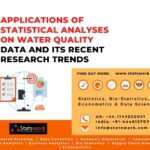Advanced Statistical Techniques and Tools for Water Quality Measurement
A water quality data typically involves a large number of measurements. These data serve as a foundation for plant operation, modelling the process, treatment planning, and economic assessments. Since having several measurements in the data, it may affect the prediction and accuracy. Thus, popular statistical techniques such as principal component analysis, factor analysis, cluster analysis, etc., can be used to group the important variables for the study.
Advanced Statistical Techniques
Principle component analysis or factor analysis is basically a dimension reduction technique and it converts the original variable into latent variable. The association between the variables can be identified using Kaiser-Meger-Olkin statistic. Similar to factor analysis, cluster analysis also group the data or variables into homogenous clusters and after getting the clusters one can identify the correlation between the homogeneous clusters. Bioinformatics tools are widely used in water quality measurement.
The dendrogram for cluster analysis is shown in figure 1.

Figure 1: Dendrogram (Source: Saad and Hamdam (2020))
Ustaoğlu et al (2020) studied the impact of water quality due to agriculture and pollution in a tropical river and adopted principle component analysis, correlation, and clustering technique and identified that the considered river data in Turkey have good quality of water and the risk factors are not affecting the public. The element concentrations in the water are measured at different season and the descriptive summaries are as shown in the following table.
Table 1: Elements in water (Source: Ustaoğlu et al (2020))

Another statistical technique to analyse the laboratory water quality data is the analysis of variance or simply, ANOVA. Analysis of variance is basically identifies the mean variability between the variables. It uses the F-statistic and based on the test statistic value, one can decide whether the proposed research hypothesis is true or false. Saad and Hamdan (2020) considered a study on plant water quality and evaluated the water quality in different areas by collecting the sample water from different rivers. Biostatistics Services used to compare monthly variation of water quality standards.
The water quality are grouped into three factors namely, biological factor, chemical factor, and physical factor. They adopted the factor analysis to identify the hidden relationship among the data. In addition, cluster analysis has been considered to group the data into three clusters. This study can also be analysed with correlation analysis or ANOVA technique to identify the relationship.
Further, Kelly et al (2020) presented a brief review of water quality based on sanitary inspection. The relationship between the sanitary inspection and the water quality has been evaluated using binary logistic regression and correlation index. The following table shows the literature review and various statistical approaches.
Table 2: Review of statistical methods (Source: Kelly et al (2020))

Future Scope
There are numerous statistical procedures or techniques to analyse the water quality data. Since the water scarcity is increasing due to lack of rainfall in many regions, finding the water quality for the recycled water, research related to turning the hard water to soft water, etc. are considered as future scope of research.
References:
- Al Saad Z.A.A., Hamdan A.N. (2020) Evaluation of Water Treatment Plants Quality in Basrah Province, by Factor and Cluster Analysis. Journal of Water and Land Development. 46 (VII–IX) pp. 10–19.
- Yuefeng Wang, Youpeng Xu, Hossein Tabari, Jie Wang, Qiang Wang, Song Song, Zunle Hu. (2020). Innovative Trend Analysis of Annual and Seasonal Rainfall in the Yangtze River Delta, Eastern China, Atmospheric Research, 231, 104673.
- Tommaso Caloiero (2020). Evaluation of Rainfall Trends in the South Island of New Zealand through the Innovative Trend Analysis (ITA). Theoretical and Applied Climatology, 139, pp. 493–504.
- Fikret Ustaoğlu, Yalçın Tepe, Beyhan Taş, (2020). Assessment of stream quality and health risk in a subtropical Turkey river system: A combined approach using statistical analysis and water quality index, Ecological Indicators, 113, pp. 1 – 12.
- Emma R. Kelly, Ryan Cronk, Emily Kumpel, Guy Howard, Jamie Bartram, (2020). How we assess water safety: A critical review of sanitary inspection and water quality analysis, Science of The Total Environment, 718, pp. 1 – 9.
.

 Previous Post
Previous Post Next Post
Next Post